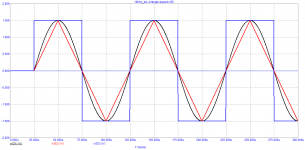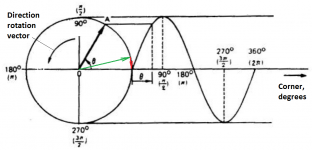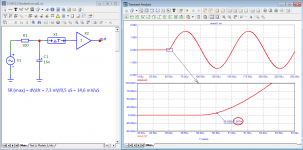Strictly speaking there is no time in the frequency domain, so there are no "subsequent periods". By taking snapshots to get around this problem, the accuracy of the frequency information is reduced. Once again, a true sinusoid has no beginning and no end. If it's truncated to one period and everything before and after is assumed to be zero, then it's no longer a true sine wave.
It is a windowed sine wave, quite different.
https://ccrma.stanford.edu/~jos/sasp/Effect_Windowing.html
https://ccrma.stanford.edu/~jos/sasp/Effect_Windowing.html
Why are we so invested in this discussion?
petr_2009,
This is past Bob's thread's scope and has become your personal soap box. I am going to highly recommend you begin your own thread to push your agenda.
petr_2009,
This is past Bob's thread's scope and has become your personal soap box. I am going to highly recommend you begin your own thread to push your agenda.
anatech, how can you study the operation of negative feedback without using test signals? I was hoping to get some clarification from Bob.
For example, here are three signals that I use in various tests.
A square wave is also good for learning how FB work, to measure SR.
The triangular signal is the most harmless of all three, it immediately shows the linearity of the gain, and other types of distortion.
If the first period of a rectangular signal does not differ from the spectrum of subsequent periods, then what is the fault of the first period of the sinusoidal signal that it must be decomposed into spectral components and attributed to it cosmic slew rates
maybe you can explain where the cosmic velocities arise in the sinusoid, or where the bouquet of spectral components comes from as in Figure 7, because you claim that today everything can be proved using a simulator
best regards
Petr
For example, here are three signals that I use in various tests.
A square wave is also good for learning how FB work, to measure SR.
The triangular signal is the most harmless of all three, it immediately shows the linearity of the gain, and other types of distortion.
If the first period of a rectangular signal does not differ from the spectrum of subsequent periods, then what is the fault of the first period of the sinusoidal signal that it must be decomposed into spectral components and attributed to it cosmic slew rates
maybe you can explain where the cosmic velocities arise in the sinusoid, or where the bouquet of spectral components comes from as in Figure 7, because you claim that today everything can be proved using a simulator
best regards
Petr
Attachments
Those cosmic slew rates are clearly visible with the naked eye. Can you not see the location, where the horizontal line makes an instantaneous 90 turn? (I would take a screenshot and highlight the exact position so it can't be missed, but I'm on mobile and even typing is a pain). You could assume that the beginning of the measurement is a smooth continuation of previous identical cycles of a sine wave, but that is not what the simulator or anyone else assumes.If the first period of a rectangular signal does not differ from the spectrum of subsequent periods, then what is the fault of the first period of the sinusoidal signal that it must be decomposed into spectral components and attributed to it cosmic slew rates
maybe you can explain where the cosmic velocities arise in the sinusoid, or where the bouquet of spectral components comes from as in Figure 7, because you claim that today everything can be proved using a simulator
best regards
Petr
Seriously?Those cosmic slew rates are clearly visible with the naked eye. Can you not see the location, where the horizontal line makes an instantaneous 90 turn? (I would take a screenshot and highlight the exact position so it can't be missed, but I'm on mobile and even typing is a pain). You could assume that the beginning of the measurement is a smooth continuation of previous identical cycles of a sine wave, but that is not what the simulator or anyone else assumes.
As you can see, I took a screenshot (I showed this place to Didden before). As you can see, the slew rate at the beginning is even lower than at the zero line crossing points between the sinusoids.
Attachments
Rate of change, then.
The extremely high delta of the slew rate between 49-50us and 50-51us does not occur anywhere else. You could make a more accurate test signal with 10 cycles, or a 100 cycles, or even 1 million cycles at 10kHz, and despite searching every microsecond, you would not find the same high delta elsewhere along the wave, except in the same position at the artificial beginning.
Yes. Seriously.
The extremely high delta of the slew rate between 49-50us and 50-51us does not occur anywhere else. You could make a more accurate test signal with 10 cycles, or a 100 cycles, or even 1 million cycles at 10kHz, and despite searching every microsecond, you would not find the same high delta elsewhere along the wave, except in the same position at the artificial beginning.
Yes. Seriously.
petr_2009,
You are pushing an unchangeable point of view in the wrong thread.
Please go to your own thread - now. I'll discuss this with others now.
You are pushing an unchangeable point of view in the wrong thread.
Please go to your own thread - now. I'll discuss this with others now.
Last edited by a moderator:
those who are interested in continuing the discussion of my testing methods can follow the link
https://www.diyaudio.com/community/threads/musings-on-amp-design-a-thread-split.366099/post-7261303
https://www.diyaudio.com/community/threads/musings-on-amp-design-a-thread-split.366099/post-7261303
Hi John!Feedback is for servos, not audio! 😀
By the way, I use significant negative feedback in most of my audio designs. I just know its negative qualities as well. Personally, I was pulled onto this thread by the moderator, but I find most of what is discussed here, rather naive, even if well stated. Just my opinon.
Also, I used the term 'we' to include Charles Hansen, Nelson Pass, and myself. I'm sorry if our 100 years of combined audio design experience doesn't count for much around here.
Go for it, feedback forever!
I largely support your reasoning about the development of amplifiers.
As for the use of feedback, I agree with Cyrill Hammer that for its correct operation, the signal propagation delay must be negligible. Only in this case, the loss of important information of the audio signal will be also negligible.
In my opinion, losses can only be measured using the compensation method.
True, this method is still difficult to implement for testing real amplifiers and can be easily used at the design stage in simulators.
How do you personally feel about this testing method?
Best regards
Petr
- Home
- Amplifiers
- Solid State
- Bob Cordell Interview: Negative Feedback



